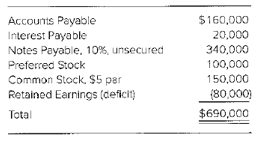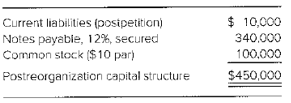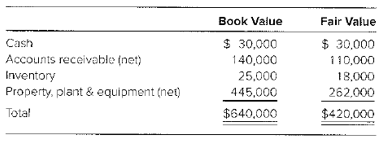
Chapter 11 Reorganization
During the recent recession, Polydorous Inc. accumulated a deficit in

A plan of reorganization is filed with the court, which approves it after review and obtaining creditor and investor votes. The plan of reorganization includes the following actions:
1. The prepetition accounts payable will be restructured according to the following: (a) $40,000 will be paid in cash, (b) $20,000 will be eliminated, and (c) the remaining $100,000 will be exchanged for a five-year, secured note payable paying 12 percent interest.
2. The interest payable will be restructured as follows: elimination of $10,000 of the interest and payment of the remaining $10,000 in cash.
3. The 10 percent, unsecured notes payable will be restructured as follows: (a) $60,000 of them will be eliminated, (b) $10,000 of them will be paid in cash, (c) $240,000 of them will be exchanges for a five-year, 12 percent secured note, and (d) the remaining $30,000 will be exchanged for 3,000 shares of newly issued common stock having a par value of $10.
4. The preferred shareholder will exchange their stock for 5,000 shares of newly issued $10 par common stock.
5. The common shareholder will exchange their stock for 2,000 shares of newly issued $10 common stock.
After extensive analysis, the company's reorganization value is determined to be $510,000 prior to any payments of cash required by the reorganization plan. An additional $10,000 in current liabilities have been incurred since the petition was filed. After the reorganization is completed, the capital structure of the company will be as follows:

An evaluation of the assets' fair values was made after the company completed its reorganization, immediately prior to the point the company emerged from the proceedings. The following information is available:

Required
a. Prepare a plan of reorganization recovery analysis for the stockholders' equity accounts of Polydorous Inc. on the day plan of reorganization is approved. (Hint: The liabilities on the plan's approval are $530,000, which is $520,000 from prepetition payables plus $10,000 in additional accounts incurred postpetition.)
b. Prepare an analysis showing whether the company qualifies for fresh start accounting as it emerges from the reorganization.
c. Prepare
d. Prepare the
a
Reorganization: Chapter 11 of bankruptcy involves a reorganization of a debtor’s business affairs. It allows legal protection from creditors’ during the time needed to reorganize and return to a profitable level. A company in financial distress files for bankruptcy may receive protection from creditors, the company continues to operate while it prepares a plan for reorganization.
A plan of reorganization recovery analysis for the liabilities and stockholders’ equity
Answer to Problem 20.6P
Pre-petition liabilities $520,000 and equity $700,000
Explanation of Solution
| Recovery | |||||||||
| Pre-confirmation ($) | Elimination of debt & equity ($) | Surviving debt ($) | Cash ($) | 12%Secured Notes ($) | Common% | Stock value ($) | Total($) | Recovery % | |
| Post − petition liabilities | (10,000) | (10,000) | (10,000) | 100 | |||||
| Claims/ Interest: | |||||||||
| Accounts payable | (160,000) | 20,000 | (40,000) | (100,000) | (140,000) | 88 | |||
| Interest payable | (20,000) | 10,000 | (10,000) | (10,000) | 50 | ||||
| Notes payable 10% | (340,000) | 60,000 | (10,000) | (240,000) | 30 | (30,000) | (280,000) | 82 | |
| Total | (520,000) | 90,000 | |||||||
| Preferred shareholders | (100,000) | 50,000 | 50 | (50,000) | (50,000) | ||||
| Common shareholders | (150,000) | 130,000 | 20 | (20,000) | (20,000) | ||||
| Retained earnings deficit | 80,000 | (80,000) | |||||||
| Total | (700,000) | 190,000 | (10,000) | (60,000) | (340,000) | 100% | (100,000) | (510,000) | |
b
Reorganization: Chapter 11 of bankruptcy involves a reorganization of a debtor’s business affairs. It allows legal protection from creditors’ during the time needed to reorganize and return to a profitable level. A company in financial distress files for bankruptcy may receive protection from creditors, the company continues to operate while it prepares a plan for reorganization.
The analysis showing whether the company qualifies for fresh start accounting as it emerges from the reorganization.
Answer to Problem 20.6P
The analysis shows that company qualifies for the fresh start accounting as it emerges from reorganization.
Explanation of Solution
First condition for fresh start:
| Post-petition liabilities | $10,000 |
| Liabilities deferred pursuant to chapter 11 | 520,000 |
| Total post-petition liabilities and claims | $530,000 |
| Reorganization value | (520,000) |
| Excess of liabilities over reorganization value | $20,000 |
Second condition:
Holders of existing voting shares immediately before confirmation receive 20% of voting shares of emerging entity.
Therefore, both conditions for a fresh start occur, and fresh start accounting is used to account for the company.
c
Reorganization: Chapter 11 of bankruptcy involves a reorganization of a debtor’s business affairs, it allows legal protection from creditors’ during the time needed to reorganize and return to a profitable level. A company in financial distress files for bankruptcy may receive protection from creditors, the company continues to operate while it prepares a plan for reorganization.
The entries for execution of the plan of reorganization with its general restructuring of debt and capital.
Explanation of Solution
| Particulars | Debit $ | Credit $ |
| Liabilities subjected to compromise | 520,000 | |
| Cash | 60,000 | |
| Notes payable | 340,000 | |
| Common stock | 30,000 | |
| Gain on debt discharge | 90,000 | |
| (Recognition of debt discharge) | ||
| Preferred stock | 100,000 | |
| Common stock old | 150,000 | |
| Common stock new | 70,000 | |
| Additional paid-in capital | 180,000 | |
| (Recording of exchange of stock) | ||
| Reorganization value in excess of amounts | ||
| Allocation to identifiable assets | 30,000 | |
| Gain on debt discharge | 90,000 | |
| Additional paid-in capital | 180,000 | |
| Accounts receivable | 30,000 | |
| Inventory | 7,000 | |
| Property, plant, and equipment | 183,000 | |
| Retained earnings deficit | 80,000 | |
| (Record fresh start accounting and elimination of deficit) |
Schedule to support allocation of reorganization value:
| Book value | Fair value | difference | |
| Cash | $30,000 | $30,000 | 0 |
| Accounts receivable | 140,000 | 110,000 | (30,000) |
| Inventory | 25,000 | 18,000 | (7,000) |
| Property, plant and equipment | 445,000 | 262,000 | (183,000) |
| Reorganization value in excess of amounts allocable to identifiable assets | 0 | 30,000 | 30,000 |
| Total | $640,000 | $450,000 | $(190,000) |
d
Reorganization: Chapter 11 of bankruptcy involves a reorganization of a debtor’s business affairs, it allows legal protection from creditors’ during the time needed to reorganize and return to a profitable level. A company in financial distress files for bankruptcy may receive protection from creditors, the company continues to operate while it prepares a plan for reorganization.
The balance sheet for the company on completion of the plan of reorganization.
Answer to Problem 20.6P
Balance sheet total as per balance sheet $450,000
Explanation of Solution
Note showing effect of plan of reorganization balance sheet:
| Pre-confirmation $ | Adjustments | Re-organized balance sheet $ | |||
| DebtDischarge $ | Exchange of Stock $ | FreshStart $ | |||
| Assets: | |||||
| Cash | 90,000 | (60,000) | 30,000 | ||
| Accounts receivable | 140,000 | (30,000) | 110,000 | ||
| Inventory | 25,000 | (7,000) | 18,000 | ||
| 255,000 | (60,000) | 0 | (37,000) | 158,000 | |
| Property, plant & equipment | 445,000 | (183,000) | 262,000 | ||
| Reorganization value in Excess amount allocated to identifiable assets | 30,000 | 30,000 | |||
| Total assets | 700,000 | (60,000) | 0 | (190,000) | 450,000 |
| Liabilities: | |||||
| Not subjected to compromise: | |||||
| Current liabilities | (10,000) | (10,000) | |||
| Subjected to compromise | (520,000) | 520,000 | |||
| Notes payable | (340,000) | (340,000) | |||
| Total liabilities | (530,000) | 180,000 | 0 | 0 | (350,000) |
| Shareholders’ equity | |||||
| Preferred stock | (100,000) | 100,000 | |||
| Common stock old | (150,000) | 150,000 | |||
| Common stock new | (30,000) | (70,000) | (100,000) | ||
| Additional paid-in capital | (180,000) | 180,000 | |||
| Retained earnings | 80,000 | (90,000) | 90,000 | ||
| (80,000) | 0 | ||||
| Total Liabilities and Equity | (700,000) | 60,000 | 190,000 | (450,000) | |
P Company
Balance sheet
| $ | |
| Assets: | |
| Cash | 30,000 |
| Accounts receivable | 110,000 |
| Inventory | 18,000 |
| Total current assets | 158,000 |
| Property, plant and equipment | 262,000 |
| Reorganization value | 30,000 |
| Total assets | 450,000 |
| Liabilities: | |
| Accounts payable | 10,000 |
| Notes payable | 340,000 |
| Total liabilities | 350,000 |
| Shareholders’ equity: | |
| Common stock | 100,000 |
| Total liabilities and shareholders’ equity | 450,000 |
Want to see more full solutions like this?
Chapter 20 Solutions
ADVANCED FINANCIAL ACCOUNTING-ACCESS
Additional Business Textbook Solutions
PRIN.OF CORPORATE FINANCE
Operations Management: Processes and Supply Chains (12th Edition) (What's New in Operations Management)
Financial Accounting, Student Value Edition (5th Edition)
Horngren's Cost Accounting: A Managerial Emphasis (16th Edition)
Marketing: An Introduction (13th Edition)
Principles of Operations Management: Sustainability and Supply Chain Management (10th Edition)
- Please provide the solution to this general accounting question using proper accounting principles.arrow_forwardPlease provide the correct answer to this general accounting problem using accurate calculations.arrow_forwardPlease explain the correct approach for solving this financial accounting question.arrow_forward
- Can you help me solve this financial accounting problem with the correct methodology?arrow_forwardPlease show me the correct way to solve this financial accounting problem with accurate methods.arrow_forwardPlease explain the correct approach for solving this general accounting question.arrow_forward
 Financial Reporting, Financial Statement Analysis...FinanceISBN:9781285190907Author:James M. Wahlen, Stephen P. Baginski, Mark BradshawPublisher:Cengage Learning
Financial Reporting, Financial Statement Analysis...FinanceISBN:9781285190907Author:James M. Wahlen, Stephen P. Baginski, Mark BradshawPublisher:Cengage Learning EBK CONTEMPORARY FINANCIAL MANAGEMENTFinanceISBN:9781337514835Author:MOYERPublisher:CENGAGE LEARNING - CONSIGNMENT
EBK CONTEMPORARY FINANCIAL MANAGEMENTFinanceISBN:9781337514835Author:MOYERPublisher:CENGAGE LEARNING - CONSIGNMENT
 Intermediate Accounting: Reporting And AnalysisAccountingISBN:9781337788281Author:James M. Wahlen, Jefferson P. Jones, Donald PagachPublisher:Cengage Learning
Intermediate Accounting: Reporting And AnalysisAccountingISBN:9781337788281Author:James M. Wahlen, Jefferson P. Jones, Donald PagachPublisher:Cengage Learning Auditing: A Risk Based-Approach (MindTap Course L...AccountingISBN:9781337619455Author:Karla M Johnstone, Audrey A. Gramling, Larry E. RittenbergPublisher:Cengage Learning
Auditing: A Risk Based-Approach (MindTap Course L...AccountingISBN:9781337619455Author:Karla M Johnstone, Audrey A. Gramling, Larry E. RittenbergPublisher:Cengage Learning





